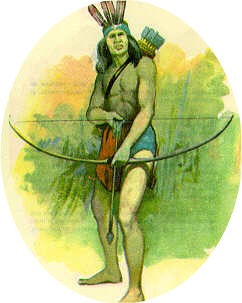Lempira was an important leader of the Indigenous resistance against Spanish domination. His area of operations was a vast and rough territory in the southern half of what is now the Lempira department in Honduras.
The chronicler Antonio de Herrera described Lempira, whose name means ‘Lord of the Mountains’, as “of medium height, thick back and thick limbs, brave, courageous and intelligent. He never had more than two women and died at the age of around 38 to 40 years old.”
In 1537, after the death of Chief Entepica, to whom Lempira served as lieutenant, Lempira called a meeting of around 200 peoples with the purpose to fight together against the Spaniards; among them was the Cares tribe, traditional enemy of the Cerquin Tribe, to which Lempira belonged.
Lempira persuaded 30.000 men to fight for their freedom, and offered to be the captain who would lead them to victory, promising to face the greatest dangers, because he considered to be unacceptable for so many bold men to be subdued by a few foreigners.
The warriors were positioned in high and fortified places called “Peñoles” (Rocky Hills) by the Spaniards, having there the entire community provisioned with abundant supplies.
The main Rocky Hills of the Indian alliance were the Gualapa hill, the Congolon peak, Coyocutena hill, the Cerquin Rock, the El Broquel and Gualasapa hills.
But the most important entrenchment was undoubtedly the Cerquin Rock, lead by Lempira himself. The Spanish governor of the province, Francisco Montejo, understood that if he wanted to advance the process of conquest he needed to seize the fortress, for which mission he appointed Captain Alonso Caceres, who with his men besieged the Rocky Hill during six months, but the Indians, who were with their wives and children well stocked with food, bravely resisted the siege, causing Spaniard casualties with their arrows, arrows which had sharp stone tips.
Seeing the brave indigenous resistance, captain Alonso Caceres decided to take the fortress by treachery. He had a soldier to approach with his horse a rock where Lempira stood, and while Caceres was making peace proposals to him, another soldier riding on the rump shot him with his musket. The ploy was fulfilled to the letter, and at the death of the Indian captain, the large force that accompanied him scattered through the mountains, and shortly after surrendered to the Spaniards.
Chronicler Herrera narrates the treachery episode: “Captain Caceres ordered a soldier to be on a horse, so close as to have good aim with the musket, and to speak to him, admonishing him to admit the friendship being offered, and that another soldier on the rump of a horse would shot him with the musket. With these instructions the soldier talked to him and said his advice and persuasions, and the chief replied that ‘The war is not going to tire the soldiers nor frighten them, and that the one who can the most will overcome’ and saying other arrogant words, of more than an Indian, the soldier on the rump pointed at him when he saw the opportunity, and struck him in the forehead, even when he wore a very gallant and crested shako.”
Tradition says that Lempira fell at the site of Piedra Parada, near the Congolon Peak, although there is another place known as Piedra Parada close to Erandique, but field investigations lead to think the Indian hero died at Cerquin Rock.
The Honduran historian Mario Felipe Martinez has cast doubts on Antonio de Herrera’s version of Lempira’s death, after discovering in the General Archive of the Indies a certificate presented in 1558 before the Spanish authorities in Mexico by the soldier Rodrigo Ruiz.
The document is very important, because it confirms the real existence of Lempira —of whom some Hondurans of low patriotic fiber consider to be a legend— the name of the chief (referred to as El Empira), the description of the war and its stage.
The purpose of the soldier Rodrigo Ruiz in writing this certificate was to impress the Spanish authorities in order to obtain a pension for the last years of his life. There Rodrigo proudly tells the tale of his one-to-one battle with Lempira, armed only with his sword and shield, carrying his head as a trophy and receiving in his way out many injuries by the Indians, injuries that almost killed him.
Although Rodrigo supports his statement with the report of several witnesses —some supposedly were present- you can not trust the testimony of some friends of war ready to help his friend in a deed of twenty years ago.
For his part, Bishop Cristobal de Pedraza, who was noted for his defense of the Indians- in a date as fresh as the May 18, 1539 reports from Gracias to the King and Queen of Spain that in order to beat Lempira ‘some industry’ was necessary, ie, not a one-to-one combat, as Ruiz says.
Source: Evolución Histórica de Honduras. Longino Becerra. (2009) Editorial Baktún.
